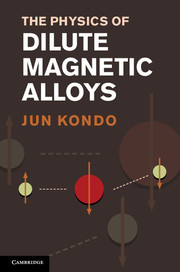9 - Recent developments
Published online by Cambridge University Press: 05 March 2013
Summary
There have been a number of notable developments in this field after the publication of the Japanese-language version of this book. The purpose of this chapter is to discuss two such topics.
The first topic involves a series of intermetallic compounds, which usually contain Ce. These have been found to have electronic heat capacity that is several hundred to thousand times greater than the corresponding heat capacity of ordinary metals. Here, although a Ce atom is magnetic, it does not interact with the neighboring Ce atoms, and it behaves as if it is an isolated magnetic atom. This fact explains the large heat capacity.
The other topic is the quantum dot. This tiny ‘artificial atom’ can be connected to leads to give rise to a system which is analogous to a system of metals with impurities. When there are an odd number of electrons in the quantum dot, the quantum dot acquires a spin, and its behavior becomes similar to that of a magnetic atom in metals. In particular, the transmission probability of an electron through the leads becomes 1 at absolute zero, and this corresponds to the unitary limit of electrical resistivity in systems with magnetic impurity.
The spin-flip rate
A spin placed inside a metal undergoes an interaction with the conduction electrons of the form eq. (5.90), which causes the inversion of the direction of the spin.
- Type
- Chapter
- Information
- The Physics of Dilute Magnetic Alloys , pp. 209 - 217Publisher: Cambridge University PressPrint publication year: 2012



